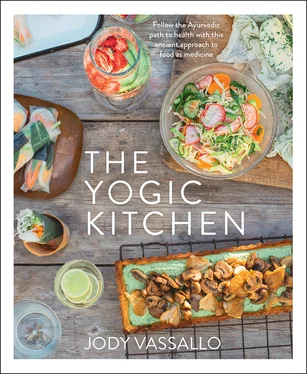I use Ayurveda on a daily basis in my health coaching practice and as a therapeutic tool with my yoga students to give them a deeper understanding of their bodies, minds and natural tendencies.
Ayurveda means science of life: ayur – science, veda – of life. It teaches that eating well is the foundation of one’s health and when we are not eating well, the body will show symptoms of illness and disease. By following the recommendations in this book it is my hope that you will gain a greater understanding of how to achieve more balance and harmony in your own life. That’s what happened for me when I discovered Ayurveda and it is the reason I continue to share my passion for this ancient science of wellness with the world through my books but also through my retreats and workshops.
THE THREE DOSHAS
The healing system of Ayurveda is based on the principle that five elements – earth, fire, water, air and space – exist both within our bodies and in the world around us. The elements combine in our bodies to form one’s constitution. These five elements, in varying degrees, comprise the three doshas (otherwise known as energetic forces of nature or functional principles) that describe one’s unique constitution (or prakruti in Ayurveda). The three doshas are known as Vata, Pitta and Kapha. Each dosha describes certain characteristics based on the elements they contain. Vata represents predominantly the quality of air, Pitta represents fire and Kapha represents water. We are all made up of varying amounts of each element and each person has a unique combination – we all have a unique proportional mix of the doshas but one may dominate. Some people have more air, others more fire and others more earth.
These elements govern the way our body responds to certain foods and lifestyle choices, and like increases like and opposites balance in Ayurveda. So a person with lots of fire in their constitution will be more susceptible to illness in the heat (Pitta dosha), a person with more water will be vulnerable in cold, damp and humid conditions (Kapha dosha) and a person dominated by air is shaken in cooler windier months (Vata dosha). The more you learn about the qualities of the elements that make up the doshas, the more it will help you determine the foods and other life choices that are best for you for balancing your dosha and that will create calm in your constitution. The elements don’t just exist in nature, they are also present in the food we eat. Some foods are more heating, some more watery, some more crisp, light and airy.
A person with a dominant Pitta (fire) dosha will thrive in the cooler months or achieve balance in the hotter months by eating cooler foods. Whereas a watery person will celebrate the warm summer months and feel more energised while feeling challenged in cooler damper climes, and warm dry foods will provide relief for these people who can feel slow and sluggish. Airy types have an aversion to the cold and hide out from the wind, they need sunshine to warm their bones and nourishing cooked foods to ground their energy. (For more on the doshas, see pages 18–21.)
When our constitutions become out of balance from the wrong kinds of food, movement, routine or environment, then our health can suffer. This is known in Ayurveda as an imbalance and, no matter what your dosha, Ayurveda will treat and deal with the imbalance first. (For more on imbalance, see Balancing the doshas, pages 22–41.)
| Vata |
Pitta |
Kapha |
| Air |
Fire |
Water |
| Space |
Water |
Earth |
So I hope you are starting to get the picture that Ayurveda is a way of living; a large part of it is food but lifestyle is also vitally important. This book is an introduction to an ancient way of living, a tool to give you more insight into your body and how it is affected by the world we live in and the choices we make.
MY AYURVEDIC JOURNEY
When I was introduced to Ayurveda through yoga, it resonated deeply with me because it asked me to look at the things I was doing and question whether they were working for me.
I thought what I was eating was healthy, I followed nutritional guidelines and ate the recommended foods but I never had cause to query the concept of a one size fits all nutrition model.
However, once I started to investigate Ayurveda and research the foods that were appropriate for me and my body type, it became pretty obvious to me they were different to what someone of a totally different body shape could tolerate.
When I looked a little deeper, as Ayurveda asks you to do, and examined myself closely, I saw that I was a bit of a controlling mess. I had been practising a style of yoga that followed a macrobiotic way of eating that was far too heating for me. I was anti sugar and my diet was full of intensely flavoured foods with lots of soy sauce, chilli, curries, miso soup and tomatoes.
The increased heat that this diet created in my body didn’t impact so much on my health but it had a field day with my mind. I had become a self-centred, highly motivated, competitive, hard-working perfectionist who had very little sweetness in her diet or her life. I functioned on overdrive with a highly regimented exercise regime, a full diary and very little time for fun or relaxation. When anything went wrong I just tried harder, worked harder and berated myself for being a failure. Nothing was ever good enough for my insane standards and I was angry and miserable.
Anyway, long story short, after carrying on like this for about 10 years I worked myself into the ground, lost my business and had a breakdown. The fire had burnt out!
Yoga was the only thing I felt would get me back on track so I took the crumbled me back to my mat, but this time I chose a different style of yoga and the principles of Ayurveda formed the foundation of this new practice. Yin yoga is a gentle, relaxing form of yoga with more passive poses and a slower pace. On those rare occasions I could quieten my mind for a moment at yoga, I started to hear messages I had needed to hear for a very long time. As I listened, I learnt that perhaps sweet stuff wasn’t all bad and that all of those intense flavours I demanded and proclaimed essential to add flavour to a meal were not as good for me as I’d believed them to be.
So I started digging, learning and experimenting with both my diet and my lifestyle.
HOW THE AYURVEDIC LIFESTYLE HELPED ME
My research revealed that I was basically a Pitta (one with a fiery constitution) who was totally out of balance. I was eating all the wrong foods and if I continued doing all of the things that I had been doing, then the misery would continue. Unfortunately, before my meltdown my need to look good in the world had overtaken my need to feel good – I’d allowed my fire to become a raging inferno.
As a Pitta, I realised if I wanted to feel better, I had to learn how to chill out, slow down and eat in a different way. I started with the food because for me that was the easiest and the hardest place to start. (For Vata types the challenge is to quieten the mind and manage their fear and anxiety. If digestive issues have started to surface, then these also need to be managed. Kapha types often have an ongoing issue with their weight and energy levels.)
I’d never really had a struggle with sugar; I’d always been more drawn to the salty, spicier, more intense flavours. So after many years of eating very little sugar, I started to add it back into my diet and I don’t mean through eating lollies and cakes (though I did tell the sheriff in me they are allowed sometimes), I mean through adding more ripe seasonal fruit into my diet, sweet vegetables and grains, sweet spices to my porridges and on birthdays I’d bake a cake.
Читать дальше












